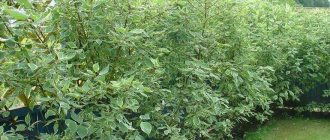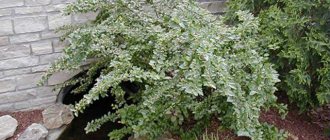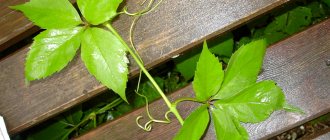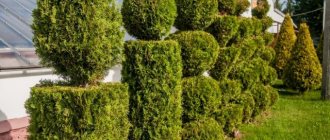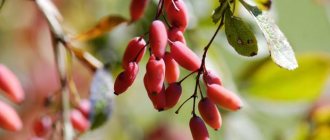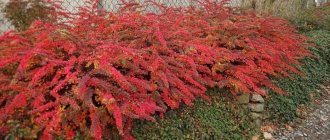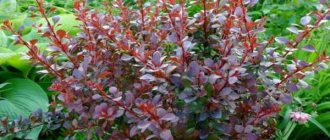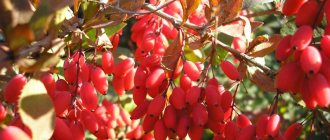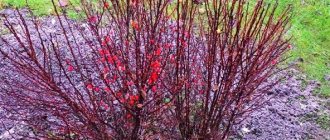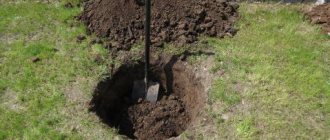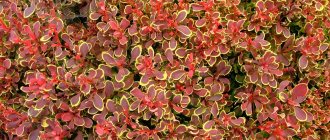This plant belongs to the category of ornamental. It is often used in landscape design to decorate flower beds, divide or highlight zones in the garden or vegetable garden, since its variegated flowers and bright berries allow this to be done as effectively as possible. Harlequin barberry was first discovered in Japan in the 19th century, where it grew on mountain slopes. In Europe and Russia, it gained popularity relatively recently, only 15-20 years ago (1998-2003), but since this variety is decorative, its fruits are inedible.
Description of Barberry Thunberg Harlequin and characteristics
Thunberg's Harlequin is a slow-growing, perennial deciduous plant. The life cycle of a shrub in artificially created conditions is 30–35 years. In the wild, the age of barberry can reach 50–60 years. The annual growth of the crop is 8–10 cm. It blooms in the fifth season and forms single inflorescences. Full fruiting occurs in the sixth year. By the age of seven, the bush grows completely.
The main distribution area is the temperate climate zone of Japan. Barberry Harlequin Thunberg has a good frost resistance. Can winter at a temperature of -250 C. Does not react to air pollution, suitable for design within megacities. The variety is drought-resistant. The crop tolerates moisture deficiency better than waterlogged soil.
In areas with stagnant water, Thunberg's barberry does not grow; in frequent cases, it dies from various infections
Place the plant only in sunny areas. In the shade, the crown loses its variegated color and becomes green. Barberry is not picky about the type of soil, but the composition must be alkaline. It is possible to grow on soil with a neutral reaction.
Important! Slightly acidic or acidic soils are not suitable for barberry. The composition is adjusted before planting and maintained throughout the entire life cycle.
Description of the plant and flowering characteristics of the Thunberga Harlequin barberry (pictured):
- It grows in the form of a branched shrub with a compact crown. Barberry height – up to 2 m, width – 70 cm.
- Perennial branches are brown with a reddish tint, thin. From the middle of the bush the shoots grow vertically. The lower branches are horizontal, with drooping tops.
- Young shoots are orange in spring and become dark red over time.
- The leaves are small, rounded, narrowed towards the base. They are collected in bunches. The leaf plates are arranged alternately.
- The main background of the leaves is dark burgundy with white, chaotically scattered strokes of different shapes and lengths. In autumn, the crown becomes monochromatic and acquires crimson colors. Leaf fall begins only after frost.
- Thunberg's Harlequin has long, thin spines arranged in groups of 1–3 along with the leaves.
- Semi-double flowers. The inner petals are bright lemon, the outer petals are burgundy. Inflorescences are formed from leaf axils located along the entire length of perennial stems.
Barberry blooms at the end of May, the cycle lasts about three weeks.
- The berries are oblong, bright red, and do not fall off until next spring, giving the plant additional decorativeness.
Harlequin barberry fruits are not toxic, but they are not eaten due to their bitter taste.
Advantages and disadvantages of the variety
All representatives of the Thunberg species do not create problems when grown. The Harlequin variety enjoys well-deserved popularity due to the following advantages:
- unusual foliage color;
- abundant flowering;
- bright fruits;
- decorative appearance throughout the year;
- resistance to frost and drought;
- versatility in design;
- ease of care.
Disadvantages include the need for lighting. The culture does not tolerate waterlogging of the soil. Poor resistance to powdery mildew and rust.
Reviews
Arkady U. “I have been growing Thunberg barberries of the Harlequin variety on my plot for more than 10 years. During this time, the plants never got sick, they grow slowly but steadily. The shrub is not afraid of drought, frost and requires minimal care.”
Alla A. “Last year I decided to green my dacha. The choice fell on the Harlequin barberry variety. I purchased the seedlings from a specialized nursery. They settled in quickly and there were no problems. The downside is the very slow growth of shoots.”
Ivan S. “I’m trying to surround my plot with a hedge. Harlequin barberry is ideal for this purpose. For every sq. I planted 4 bushes per meter, it should turn out very beautiful.”
Reproduction methods
In its natural environment, Thunberg's Harlequin reproduces by seeds. Seedlings completely retain the morphological and varietal characteristics of the parent plant. The generative method can be used independently; the seeds germinate well, but the seedlings grow for three years before being transferred to a permanent place, so gardeners most often propagate barberry vegetatively.
Layering method:
- in the spring, before sap flow, the lower branch is fixed to the ground surface;
- covered with a layer of soil;
- maintain humidity by periodic watering;
- They are well covered for the winter.
The next season, the rooted buds will sprout. The cuttings are dug up, plots are cut and planted around the end of August.
The process of propagation by cuttings:
- Last year's shoots are used to obtain the material. Cuttings 10 cm long are cut from the tops in the spring.
- Place it in a container with a nutrient substrate or make a queen cell on the site.
- For the winter, the structure is carefully insulated. If the barberry is in a container, then it is brought into a room where the temperature does not rise above +40 C.
- In spring they are planted on the site.
Attention! Dividing the plant is possible, but not advisable.
Thunberg's adult Harlequin is not settling well in his new place. If there is a need for transfer and division, work is carried out in early spring. Treat the root and soil with Kornevin and apply nitrogen fertilizer. These activities increase the chance of barberry survival.
How does a plant reproduce?
Barberry - popular varieties, description
The main methods of plant propagation are:
- planting seeds;
- cuttings;
- dividing the bush;
- planting root shoots.
The best method of plant propagation, recommended by gardeners, is cuttings. The time to cut side shoots for cuttings is early June. After the procedure has been completed, the cuttings are placed in a solution that stimulates root growth for a couple of hours.
Next, the plant is placed in a mixture of sand and peat and covered with glass. The substrate must be moistened and ventilated daily. After the leaves begin to appear, it is necessary to transplant the cuttings into a pot with special soil. After a year, the seedlings are sent to open areas where they will grow continuously.
Barberry in landscape design
Planting and caring for Harlequin barberry
The Harlequin variety is grown in a place that is open to the sun but protected from the north wind. An area with close groundwater is not considered; Thunberg barberry is not located next to tall junipers.
Important! If rust on an ephedra can be spotty, then the barberry located nearby will be completely affected by the disease.
Planting work is carried out in the spring (approximately in May), when the temperature reaches above zero.
Barberry from a container is planted by transshipment
The crop can also be planted at the end of the season. There should be 1.5 months left before frost. This time is enough for the seedling to adapt.
Planting Harlequin barberry:
- Make a mixture of humus and turf layer (1:1), add 20 g of superphosphate to the hole. If the soil is heavy, add sand and peat.
- Dig a hole 55 cm deep and 35–40 cm wide. There should be 10–15 cm left on all sides to the edge of the hole.
- Drainage and nutrient mixture are placed at the bottom.
- A bare-rooted seedling is disinfected and placed in the center of the recess.
- Cover with the rest of the substrate. The root collar is placed 3–5 cm above the soil surface.
- The root circle is compacted and watered.
Advice! To prevent the root from drying out and overheating, the barberry is mulched after planting.
When placing plants in a line, maintain a distance of 50 cm between them.
Agrotechnical measures consist of the following points:
- Barberry Harlequin is a drought-resistant plant. During reproductive age, it can cope with seasonal precipitation. During abnormal drought, Thunberg barberry is watered with plenty of water once a week. During the planting season, seedlings require regular moistening with a small volume of water.
- Harlequin Thunberg is fed from the second year of growth; in the first season, a nutritious substrate is enough for him. At the beginning of the growing season, nitrogen and organic matter are added, during flowering - phosphorus and potassium, in the fall - superphosphate and compost.
- Barberries are weeded to remove weeds and maintain soil aeration. The schedule depends on the frequency of crust formation. If the tree trunk circle is mulched, then there is no need for this.
- The Harlequin barberry is trimmed in July, but the procedure is not mandatory and depends on the design concept. Pruning is necessary in the fall. The bush is thinned out, dry branches and branches growing inside are removed. In the spring, frozen areas are cut off. Thunberg's barberry needs a rejuvenating procedure at the age of ten. In the future, the event is held once every 4 years.
- An adult bush of the Harlequin variety does not require crown cover for the winter. If the stems partially freeze, the barberry will completely form a replacement. The main task is to preserve the root. The trunk circle is covered with a layer of compost and straw. Thunberg's young Harlequin will not survive the winter without insulation. The plant is hilled up, mulched, and covered with insulation.
Pests and diseases
Barberry Thunberg Harlequin is characterized by medium resistance to fungus. The crop often suffers from powdery mildew. For prevention, the bush is treated with copper sulfate at the beginning of the season. At the first signs, the affected parts of the crown are cut off and sprayed with Fitosporin.
When rust spreads, “Horus” is used for treatment
The main damage to the Thunberg Harlequin variety is caused by:
- aphid;
- moth;
- sawfly;
- spider mite
In the spring, treat the bush with Bordeaux mixture; when insects appear, use: “Aktellik”, “Aktaru”, “Engio”.
Barberry Harlequin in landscape design
Harlequin with variegated foliage will be appropriate both in the garden and on the site.
Barberry Thunberg is often used as a tapeworm
The plant is relaxed about pruning; the bush can be given any curly or geometric shape.
The bright foliage of Harlequin looks advantageous against the background of dwarf conifers
Barberry can be grown as a hedge
The culture harmoniously combines with almost all species that have the same requirements for the place of growth and soil composition.
Beneficial features
Harlequin barberry is edible, which is why many gardeners grow it in their gardens. The red berries have an interesting flavor. In cooking, they are used as a seasoning, adding to main dishes. Many housewives cook compotes, jelly, and make fruit drinks from the fruits.
Barberry berries
The main benefit of barberry berries is strengthening the immune system. They allow you not to get sick during the cold season and to recover quickly if a person is nevertheless attacked by a virus. Hypertensive patients are recommended to drink berry decoctions. However, before starting treatment with folk remedies, it is important to consult a doctor.
The described variety of barberry is an ideal decoration for a summer cottage. Moreover, it can be planted around a private house where a person lives permanently. Easy to care for and producing healthy fruits, the plant is popular among gardeners. Growing it, creating unique shapes and figures, hedges, labyrinths is a real pleasure for a person with excellent aesthetic taste.
